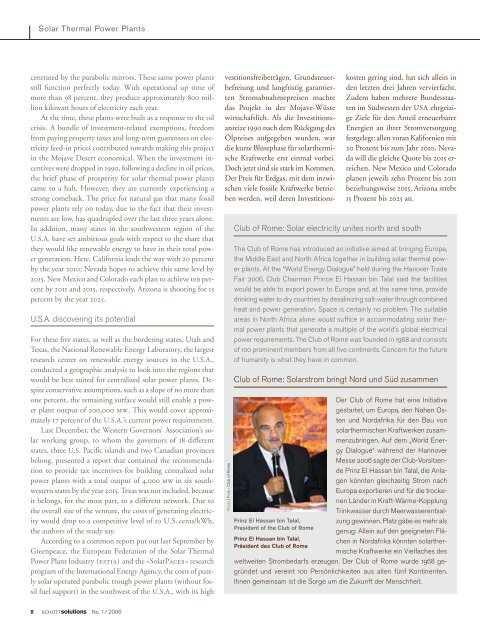Create successful ePaper yourself
Turn your PDF publications into a flip-book with our unique Google optimized e-Paper software.
Solar Thermal Power Plants<br />
centrated by the parabolic mirrors. These same power plants<br />
still function perfectly today. With operational up time of<br />
more than 98 percent, they produce approximately 800 million<br />
kilowatt hours of electricity each year.<br />
At the time, these plants were built as a response to the oil<br />
crisis. A bundle of investment-related exemptions, freedom<br />
from paying property taxes and long-term guarantees on electricity<br />
feed-in prices contributed towards making this project<br />
in the Mojave Desert economical. When the investment incentives<br />
were dropped in 1990, following a decline in oil prices,<br />
the brief phase of prosperity for solar thermal power plants<br />
came to a halt. However, they are currently experiencing a<br />
strong comeback. The price for natural gas that many fossil<br />
power plants rely on today, due to the fact that their investments<br />
are low, has quadrupled over the last three years alone.<br />
In addition, many states in the southwestern region of the<br />
U.S.A. have set ambitious goals with respect to the share that<br />
they would like renewable energy to have in their total power<br />
generation. Here, California leads the way with 20 percent<br />
by the year 2010; Nevada hopes to achieve this same level by<br />
2015. New Mexico and Colorado each plan to achieve ten percent<br />
by 2011 and 2015, respectively. Arizona is shooting for 15<br />
percent by the year 2025.<br />
U.S.A. discovering its potential<br />
For these five states, as well as the bordering states, Utah and<br />
Texas, the National Renewable Energy Laboratory, the largest<br />
research center on renewable energy sources in the U.S.A.,<br />
conducted a geographic analysis to look into the regions that<br />
would be best suited for centralized solar power plants. Despite<br />
conservative assumptions, such as a slope of no more than<br />
one percent, the remaining surface would still enable a power<br />
plant output of 200,000 mw. This would cover approximately<br />
17 percent of the U.S.A.’s current power requirements.<br />
Last December, the Western Governors’ Association’s solar<br />
working group, to whom the governors of 18 different<br />
states, three U.S. Pacific islands and two Canadian provinces<br />
belong, presented a report that contained the recommendation<br />
to provide tax incentives for building centralized solar<br />
power plants with a total output of 4,000 mw in six southwestern<br />
states by the year 2015. Texas was not included, because<br />
it belongs, for the most part, to a different network. Due to<br />
the overall size of the venture, the costs of generating electricity<br />
would drop to a competitive level of 10 U.S. cents/kWh,<br />
the authors of the study say.<br />
According to a common report put out last September by<br />
Greenpeace, the European Federation of the Solar Thermal<br />
Power Plant Industry (estia) and the »SolarPaces« research<br />
program of the International Energy Agency, the costs of purely<br />
solar operated parabolic trough power plants (without fossil<br />
fuel support) in the southwest of the U.S.A., with its high<br />
8 schottsolutions No. 1/ 2006<br />
vestitionsfreibeträgen, Grundsteuerbefreiung<br />
und langfristig garantierten<br />
Stromabnahmepreisen machte<br />
das Projekt in der Mojave-Wüste<br />
wirtschaftlich. Als die Investitionsanreize<br />
1990 nach dem Rückgang des<br />
Ölpreises aufgegeben wurden, war<br />
die kurze Blütephase für solarthermische<br />
Kraftwerke erst einmal vorbei.<br />
Doch jetzt sind sie stark im Kommen.<br />
Der Preis für Erdgas, mit dem inzwischen<br />
viele fossile Kraftwerke betrieben<br />
werden, weil deren Investitions-<br />
Photo | Foto : Club of Rome<br />
kosten gering sind, hat sich allein in<br />
den letzten drei Jahren vervierfacht.<br />
Zudem haben mehrere Bundesstaaten<br />
im Südwesten der USA ehrgeizige<br />
Ziele für den Anteil erneuerbarer<br />
Energien an ihrer Stromversorgung<br />
festgelegt: allen voran Kalifornien mit<br />
20 Prozent bis zum Jahr 2010, Nevada<br />
will die gleiche Quote bis 2015 erreichen.<br />
New Mexico und Colorado<br />
planen jeweils zehn Prozent bis 2011<br />
beziehungsweise 2015, Arizona strebt<br />
15 Prozent bis 2025 an.<br />
Club of Rome: Solar electricity unites north and south<br />
The Club of Rome has introduced an initiative aimed at bringing Europe,<br />
the Middle East and <strong>North</strong> Africa together in building solar thermal power<br />
plants. At the “World Energy Dialogue” held during the Hanover Trade<br />
Fair 2006, Club Chairman Prince El Hassan bin Talal said the facilities<br />
would be able to export power to Europe and, at the same time, provide<br />
drinking water to dry countries by desalinizing salt-water through combined<br />
heat and power generation. Space is certainly no problem. The suitable<br />
areas in <strong>North</strong> Africa alone would suffice in accommodating solar thermal<br />
power plants that generate a multiple of the world’s global electrical<br />
power requirements. The Club of Rome was founded in 1968 and consists<br />
of 100 prominent members from all five continents. Concern for the future<br />
of humanity is what they have in common.<br />
Club of Rome: Solarstrom bringt Nord und Süd zusammen<br />
Prinz El Hassan bin Talal,<br />
President of the Club of Rome<br />
Prinz El Hassan bin Talal,<br />
Präsident des Club of Rome<br />
Der Club of Rome hat eine Initiative<br />
gestartet, um Europa, den Nahen Osten<br />
und Nordafrika für den Bau von<br />
solarthermischen Kraftwerken zusammenzubringen.<br />
Auf dem „World Energy<br />
Dialogue“ während der Hannover<br />
Messe 2006 sagte der Club-Vorsitzende<br />
Prinz El Hassan bin Talal, die Anlagen<br />
könnten gleichzeitig Strom nach<br />
Europa exportieren und für die trockenen<br />
Länder in Kraft-Wärme-Kopplung<br />
Trinkwasser durch Meerwasserentsalzung<br />
gewinnen. Platz gäbe es mehr als<br />
genug: Allein auf den geeigneten Flächen<br />
in Nordafrika könnten solarthermische<br />
Kraftwerke ein Vielfaches des<br />
weltweiten Strombedarfs erzeugen. Der Club of Rome wurde 1968 gegründet<br />
und vereint 100 Persönlichkeiten aus allen fünf Kontinenten.<br />
Ihnen gemeinsam ist die Sorge um die Zukunft der Menschheit.

















